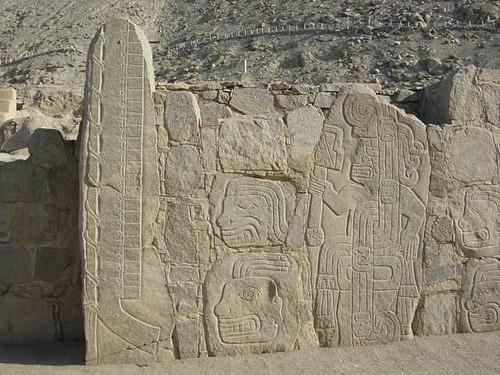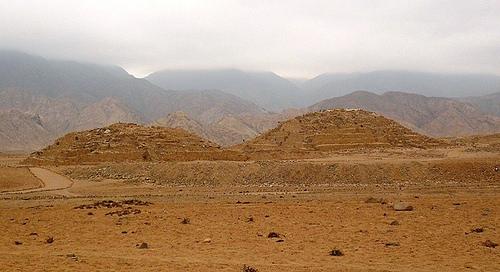Archaeologists have uncovered monumental finds in recent years that testify to early urbanized civilization dating back at least 5500 years ago in Peru.
Source - http://popular-archaeology.com/issue/june-2013/article/the-new-worlds-first-monumental-civilization
 The Sechin Bajo archaeological site, nestled in Peru's Casma Valley. Sylvain2803, Wikimedia Commons
The Sechin Bajo archaeological site, nestled in Peru's Casma Valley. Sylvain2803, Wikimedia Commons
Before the great pyramids arose on the ancient Giza Plateau in Egypt, thousands of miles to the west a thriving ancient civilization began constructing monumental structures not far from the Andes mountains in what is today Peru. Like the ancient Egyptians, they too were a deeply religious people, creating what they believed would be a lasting legacy to their gods and kings. Unlike the ancient Egyptians on the other side of the world, however, these people would eventually pass into oblivion—there were no ancient records and no pottery, other than buried structures, to testify of their existence. It would be left to archaeology to raise them into modern consciousness.
In 2008, a team of archaeologists hunched over an excavation in a dry clearing among cultivated fields of the Casma Valley, near Peru’s north-central coast. Here, led by German archaeologist Peter Fuchs, they uncovered a circular, sunken plaza built of stones and adobe. Radiocarbon dating of the materials unearthed at the feature revealed that it had been built between 3500 and 3000 BCE, or as much as 5500 years ago, making it arguably the oldest monumental structure found in the New World. It was the latest and perhaps most sensational discovery at the Sechin Bajo archaeological complex, a site that teams of archaeologists had been investigating since 1992. It demonstrated that an ancient Peruvian people were building structures typical
of ancient urban settlements around the same time as the people of Mesopotamia, Egypt, and India, long considered the earliest architects of urbanized civilization. “Whoever built Sechin Bajo had a good knowledge of architecture and construction,” said Fuchs to a Los Angeles reporter.* A chief difference between the builders of Sechin Bajo and the builders in Mesopotamia and Egypt—the Sechin Bajo people had no pottery.
The archaeologists believe the plaza, measuring 33 to 39 feet across, may have been a gathering site or ceremonial center. An adjacent structure, built around 1800 BCE, featured an adobe frieze depicting a six-foot tall figure with open arms, holding a knife and a human head. Fuchs interprets it as a scene of human sacrifice. It was an image and theme found in excavations at archaeological sites representing later cultures in Peru, such as the famous Lords of Sipan tombs of the Moche culture on Peru’s northern coast.
 Relief carvings found at the Sechin Bajo site. Wikimedia Commons
Relief carvings found at the Sechin Bajo site. Wikimedia Commons
But the 2008 discovery at Sechin Bajo is not the only site where the remains of very early urbanized civilization in Peru have been discovered. Near the north-central coast archaeologists have unearthed a series of sites that have revealed communal monumental architecture, such as terraced platform mounds, sunken plazas, temple structures, and the beginnings of elaborate art. They are manifestations of the Norte Chico, a Preceramic culture that flourished around 5,000 years ago. Examples of this culture can now be found at sites such as Caral and Huaricanga, which feature massive platform mounds.
 The large, 5,000-year-old platform mounds at Caral. Percy Meza, Wikimedia Commons
The large, 5,000-year-old platform mounds at Caral. Percy Meza, Wikimedia Commons
Who exactly were these people? Did they establish the foundations for all later Andean cultures, including the Chavín, previously thought to have been Peru’s oldest urbanized culture, and the well-known Inca? Archaeologists continue to investigate the sites to find the answers.